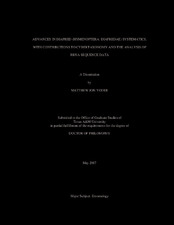| dc.description.abstract | Diapriids (Hymenoptera: Diapriidae) are small parasitic wasps. Though found
throughout the world they are relatively unknown. A framework for advancing diapriid
systematics is developed by introducing a new web-based application/database capable
of storing a broad range of systematic data, and the first molecular phylogeny
specifically focused at examining intrafamilial relationships. In addition to these efforts,
a description of a new taxon is provided. Several advantages of digital description,
including linking descriptions to an ontology of morphological terms, are highlighted.
The functionality of the database is further illustrated in the production of a catalog of
diapriid host associations. The hosts database currently holds over 450 association
records, for over 500 named taxa (parasitoids and hosts), and over 180 references.
Diapriids are found to be primarily endoparasitoids of Diptera emerging from the host
pupa. Phylogenetic inference for a molecular dataset of 28S and 18S rRNA sequence
data, derived from a diverse selection of diapriids, is accomplished with a new suite of
tools developed for handling complex rRNA datasets. Several parsimony-based
methodologies, including an alignment-free method of analyzing multiple sequences, are
reviewed and applied using the new software tools. Diapriid phylogenetic relationships
are shown to be broadly congruent with existing morphology-based classifications.
Methods for analyzing typically excluded sequence data are shown to recover
phylogenetic signal that would otherwise be lost and the alignment-free method
performed remarkably well in this regard. Empirically, phylogenetic approaches that
incorporate structural data were not notably different than those that did not. | en |


